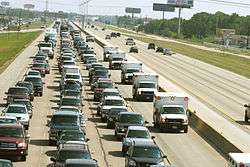Hurricane evacuation


Hurricane evacuation is the immediate and rapid movement of people away from the threat or actual occurrence of a hurricane. Local authorities in a predicted hurricane path often recommend or order evacuation of designated flood zones.
Some jurisdictions, such as Pinellas County, Florida, use the output from the Sea, Lake, and Overland Surge from Hurricanes (SLOSH) storm surge model developed by the U.S. Federal Emergency Management Agency (FEMA) to create their evacuation zones. These zones loosely correspond to the maximum expected storm surge expected during a category of hurricane. Since these evacuation maps are used by the general public and a more static nature is desirable, some minor averaging or ranging of data is performed before creating the maps. Changes in variables such as mean high-tide, forward speed and direction of the hurricane, and central pressure all affect the output of the SLOSH model.
The longer a person has lived in a coastal area, the less likely they are to evacuate. Hurricanes have a longer warning time than most disasters, but details of strength and track are only educated guesses. Official warnings, as with other scenario planning, are based on a worst case, which is not the most probable case. Thus, hurricanes can be predicted to hit a coastal town many times without the town ever actually experiencing the brunt of a storm. When this more probable case happens a number of times, people tend to take evacuation orders less seriously.
If evacuation orders are given too early, the hurricane can change course and leave the evacuated area unscathed. People may think they have weathered hurricanes before, when in reality the hurricane didn't hit them directly, giving them false confidence. Those who have lived on the coast for ten or more years are the most resistant to evacuating.
Despite mandatory evacuation orders, many people did not leave New Orleans, United States, as Hurricane Katrina approached. Even after the city was flooded and uninhabitable, some people still refused to leave their homes.[1][2]
Determining if Evacuation is Necessary
Due to the danger of hurricanes, evacuating should always be an option during strong hurricanes. Some residents may believe that due to the monetary cost of evacuation and the price of not being there to care for your home, evacuation is not a good choice. Due to the potential health and safety risks, some areas and people should give evacuating more thought.
Hurricane evacuation can be vital to individual safety in some circumstances. You should evacuate if:[3]
- past hurricanes has caused storm surge damage
- your home is built on flood plane areas
- you live in a mobile home
- your home lacks hurricane structural reinforcement [4]
- local officials recommend evacuation
If you decide not to evacuate, families and individuals should carefully monitor the hurricane updates provided by local the local television and radio crews. The strength of the hurricane may suddenly change based unanticipated converging storm or wind patterns.
Means
Private cars may not be an efficient means of evacuating. The traffic jams that thousands of motorists experienced in South Carolina while fleeing Hurricane Floyd and Texas while fleeing Hurricane Rita exemplify the frustration of people trying to evacuate. Some jurisdictions have implemented contraflow lane reversal plans in an attempt to increase outbound traffic capacity from coastal areas, but traffic jams remain a fact of life in these situations. Many buses and coaches in New Orleans can change their destination boards to "EVACUATION" in times of a hurricane, effectively doubling as ambulances.
Social capital refers to the connections between people: social networks and the reciprocity and trust within them. The social systems of communities can have a large impact on their ability and willingness to evacuate. Weak social networks within a community can make evacuation difficult. If people don't trust each other, then they are likely to fear that their homes or stores will be looted if they evacuate. Communities that have the physical capital, such as cars, to evacuate everyone may not have the social capital to facilitate sharing these resources. However, strong social networks within a community can also hinder evacuation by increasing the ties to the neighborhood and refusing to evacuation.
See also
- Civil defense
- Emergency Management
- Evacuation process simulation
- List of mass evacuations
- Air safety#Emergency airplane evacuations
- Shelter in place
References
- Abrahams, John: "Fire escape in difficult circumstances", chapter 6, In: Stollard, 1994, "Design against fire".
- Gershenfeld, Neil, Mathematical Modelling. OUP, Oxford, 1999.
- Hubert Klüpfel, A Cellular Automaton Model for Crowd Movement and Egress Simulation. Dissertation, Universität Duisburg-Essen, 2003.
- Stollard, P. and L. Johnson, Eds., "Design against fire: an introduction to fire safety engineering design", London, New York, 1994.
External links
- The International Emergency Management Society
- A bibliography for pedestrian simulation and evacuation dynamics
- Fire Safety Engineering Group at the University of Greenwich
- PESOS and BYPASS, research projects concerning the "Evacuation of Passenger Ships" (University Duisburg-Essen, Germany)
- Panic Simulation (Budapest University)
- Dirk Helbing's homepage
- City evacuation study, Tokyo Institute of Technology
- Decontamination - prior to evacuation where possible.
- Evacuation routes for the US by state.
- NY State Evacuation (Individual residence zone information)